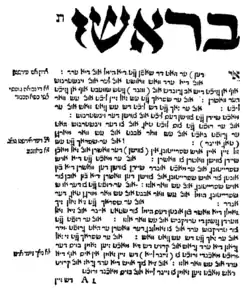Vaybertaytsh
Vaybertaytsh (Yiddish: װײַבערטײַטש, lit. 'women's taytsh') or mashket (Yiddish: מאַשקעט),[note 1] is a semi-cursive script typeface for the Yiddish alphabet. From the 16th until the early 19th century, the mashket font distinguished Yiddish publications, whereas Hebrew square script were used for classical texts in Hebrew and Aramaic, and "Rashi" script for rabbinic commentaries and works in Ladino.[4]

Mashket was used for printing Yiddish in the Old Yiddish literature period, and later as the primary script used in texts for and by Jewish women, ranging from folktales to women's supplications and prayers, to didactic works.[5]
Description

Unlike Yiddish block or square print (the script used in modern Hebrew, with the addition of special characters and diacritics), vaybertaytsh is a semi-cursive script, akin to the "Rashi" script. Vaybertaytsh may be handwritten or typed.
History
Mashket originated as a typeface imitating the Ashkenazic semi-cursive used for both Hebrew and Yiddish. The earliest extant printed book in which Yiddish constituted a major segment, The Second Chariot (Hebrew: מרכבת המשנה) (1534), attributed to Rabbi Anshel ben Eliakim ha-Levi Tsion, was written in mashket.[2] The type family came to be used almost exclusively for Yiddish with the dominance use of block and "Rashi" scripts (the latter based on Sephardic semi-cursive) by early Hebrew typographers such as the Soncino family.[2][6]
The typeface later became associated with devotional women's literature. As a result of their not being present in the yeshivot, women were usually fluent only in the Yiddish (the vernacular among Ashkenazi Jews), and literate only in Yiddish, if at all.[7] Thus early religious works in Yiddish were mostly created for women's edification. The Tseno Ureno was a Yiddish-language prose adaptation of the Chumash, its corresponding Haftarah portions, and the Megillot. It dates to at least 1622 and has been published in block print and vaybertaytsh.[8] Similarly, tkhines were supplicatory prayers written in Yiddish (usually for women) rather than in Hebrew and Aramaic, in contrast to the normative Jewish liturgy. They proliferated in the 16th and 17th centuries, and continued to be written and published, usually in vaybertaytsh, into the early- to mid-20th century.[9]
Square print began to replace vaybertaytsh in Yiddish books in the 1830s.[10] By the late 19th century, nearly all books in Yiddish were printed in square letters.[11][12]
Notes
References
- Katz, Dovid. "Language: Yiddish". YIVO Encyclopedia of Jews in Eastern Europe. Retrieved 5 December 2018.
- Zafren, Herbert C. (1982). "Variety in the Typography of Yiddish: 1535-1635". Hebrew Union College Annual. Hebrew Union College. 53: 137–163. JSTOR 23507628.
- Jacobs, Neil G. (2005). Yiddish: A Linguistic Introduction. Cambridge University Press. p. 47. ISBN 978-0-521-77215-0.
- Kamusella, Tomasz (2009). The Politics of Language and Nationalism in Modern Central Europe. Palgrave Macmillan. p. 311. ISBN 978-0-230-55070-4.
- Frakes, Jerold C. (2017). "Mashket script/font". A Guide to Old Literary Yiddish. Oxford University Press. p. 96. ISBN 978-0-19-878502-6.
- Stern, David (22 October 2017). The Jewish Bible: A Material History. University of Washington Press. p. 182. ISBN 978-0-295-74149-9. Retrieved 18 November 2018.
- Hyman, Paula E. (9 August 2010). "Gender". YIVO Encyclopedia of Jews in Eastern Europe. Retrieved 5 December 2018.
- Turniansky, Chava. "Ze'enah U-Re'enah". Jewish Women: A Comprehensive Historical Encyclopedia. Retrieved 5 December 2018.
- Weissler, Chava. "Tkhines". YIVO Encyclopedia of Jews in Eastern Europe. Retrieved 5 December 2018.
- Roskies, David G. (1995). A Bridge of Longing: The Lost Art of Yiddish Storytelling. Harvard University Press. p. 60. ISBN 0-674-08139-0. OCLC 60163772.
- Mitchell, Bruce (2006). Language Politics and Language Survival: Yiddish Among the Haredim in Post-War Britain. Peeters Publishers. p. 78. ISBN 90-429-1784-9.
- Lewis, Justin Jaron (2009). Imagining Holiness: Classic Hasidic Tales in Modern Times. Montreal & Kingston: McGill-Queen's University Press. ISBN 978-0-7735-3519-0. JSTOR j.ctt809r8.